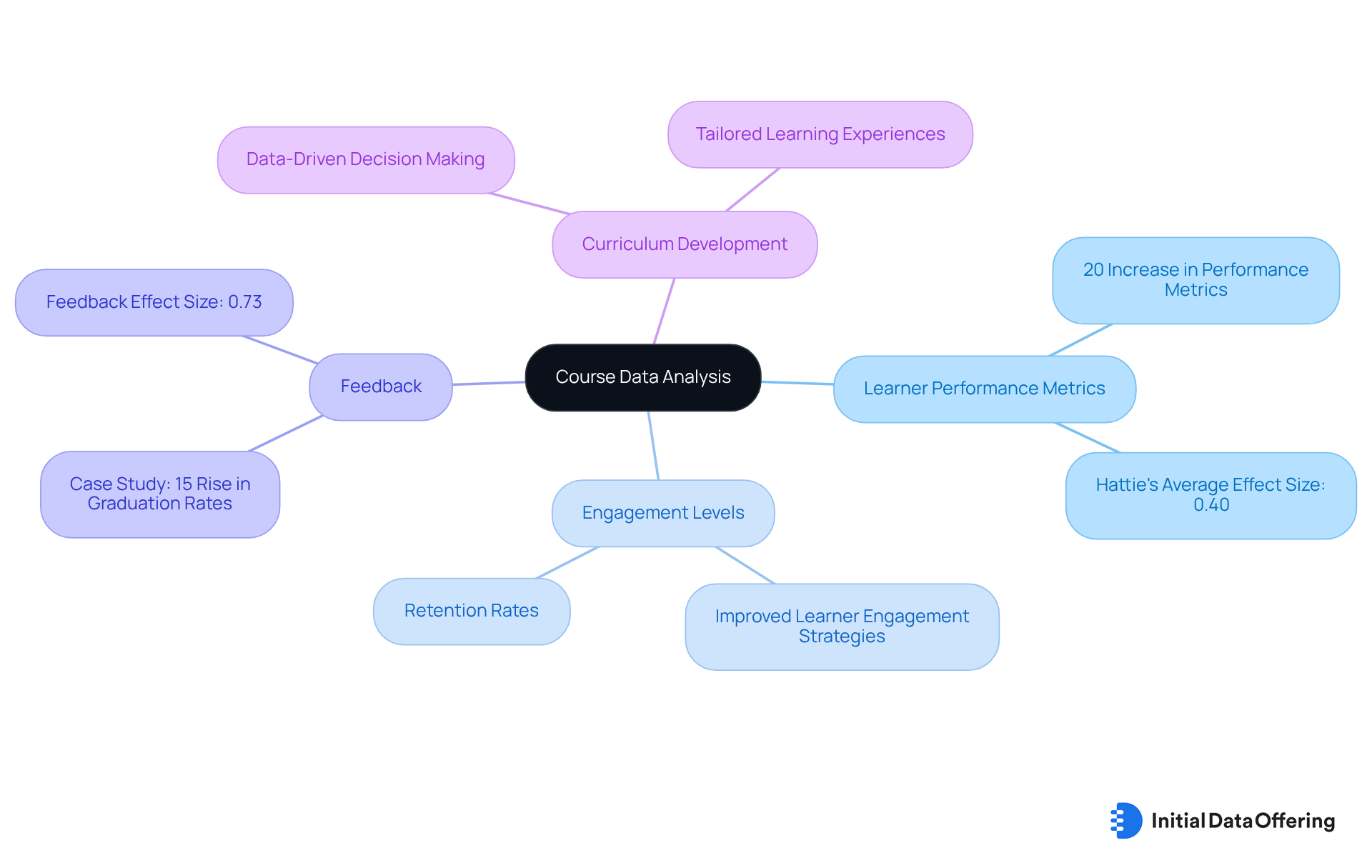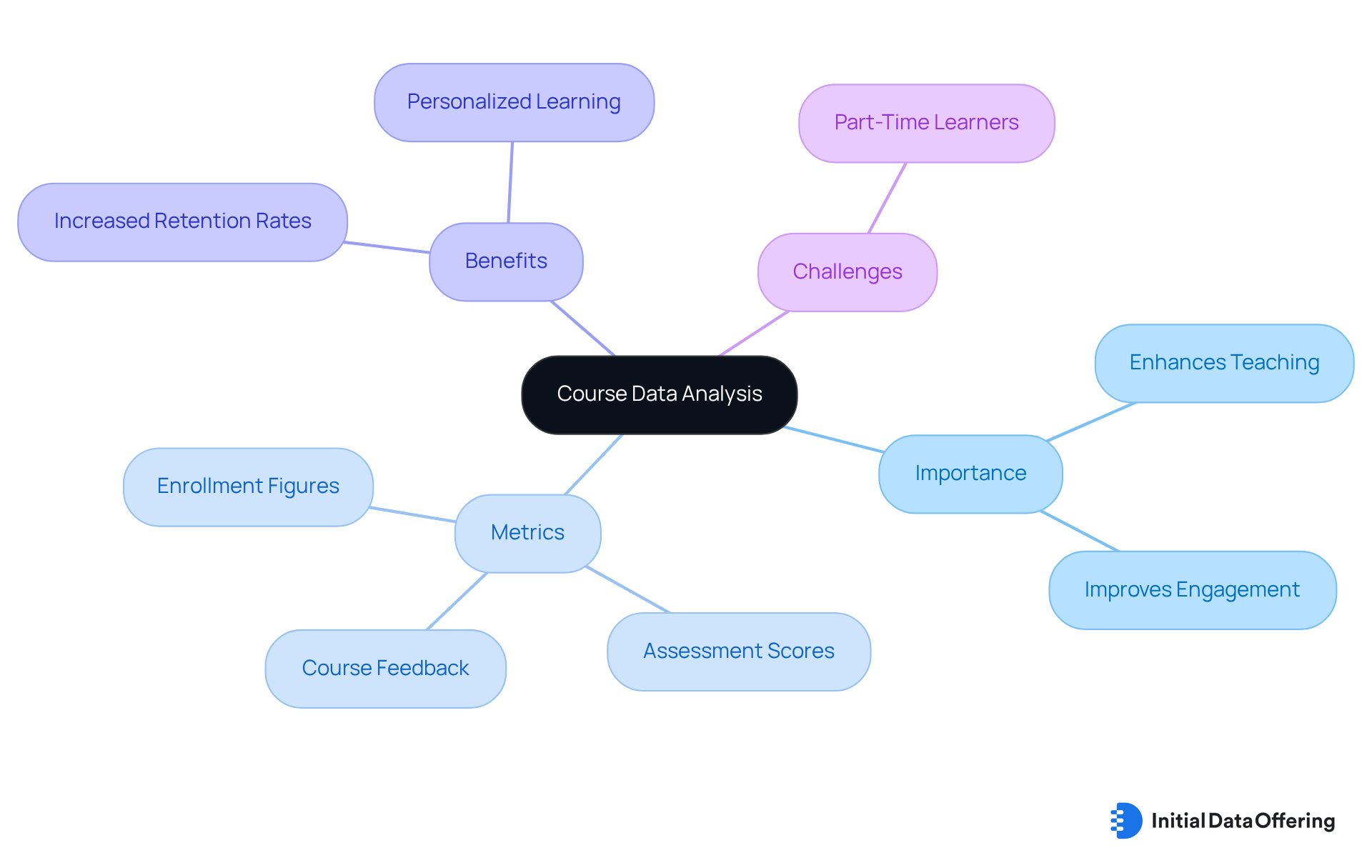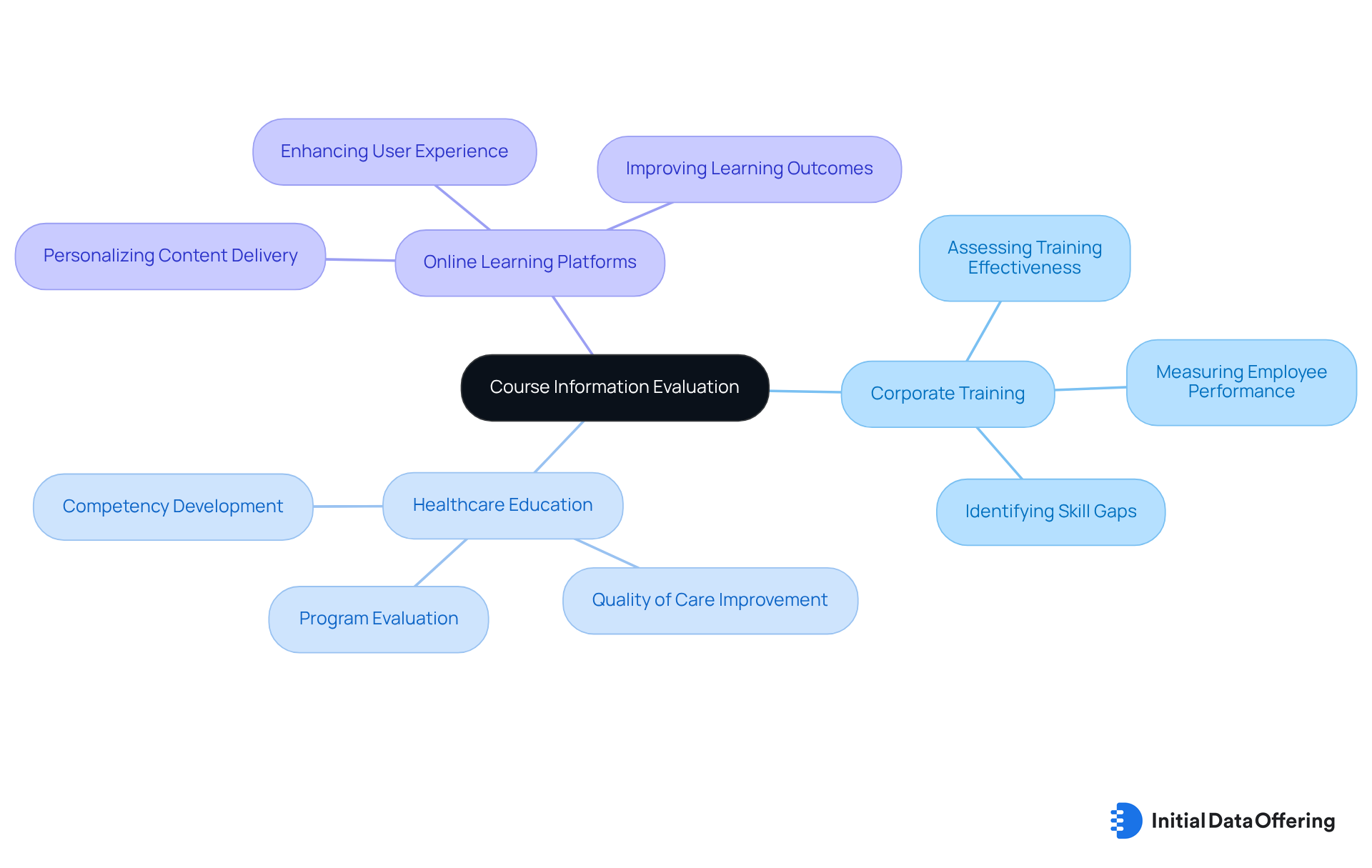Course Data Analysis: Definition, Importance, and Key Characteristics

Course Data Analysis: Definition, Importance, and Key Characteristics
Overview
Course data analysis is defined as the systematic evaluation of information from educational programs. This process is essential for enhancing teaching methods and improving learner outcomes. By utilizing data-driven insights, educational institutions can achieve significant improvements in academic performance.
For instance, this analysis can lead to increased graduation rates and enhanced learner engagement. Thus, it underscores the critical role of analytics in modern education.
How can your institution leverage this data to foster better educational experiences? The implications of effective data analysis are profound, providing actionable insights that can transform teaching and learning.
Introduction
Course data analysis is pivotal in the realm of educational innovation, transforming raw data into valuable insights that can significantly elevate teaching and learning outcomes. By systematically evaluating features such as learner performance, engagement, and feedback, this analytical approach offers educators the advantage of tailoring their strategies. This ensures that diverse student needs are met while fostering a culture of accountability.
As educational institutions increasingly adopt data-driven decision-making, a crucial question emerges: how can they effectively leverage course data analysis to enhance learner retention and engagement and drive overall academic success?
Define Course Data Analysis
Course data analysis involves the methodical evaluation of information produced from educational programs, encompassing learner performance metrics, engagement levels, and feedback. This examination seeks to generate practical insights that can enhance teaching methods, , and guide curriculum development. By employing various analytical techniques in course data analysis, educators and administrators can identify trends, assess the effectiveness of instructional strategies, and make data-driven decisions to create a more effective learning environment.
The effect of course information evaluation on learner performance metrics is significant. Studies show that organizations utilizing analytics have experienced notable advancements in learner success. For example, schools that adopted data-informed decision-making processes reported an average rise in performance metrics by 20%. This emphasizes the significance of utilizing information to customize learning experiences to address varied learner requirements. John Hattie's research discovered that the average effect size of all interventions examined was 0.40, offering a standard for anticipated enhancements in learner outcomes.
In 2025, the importance of course data analysis in education keeps expanding, as educational institutions increasingly acknowledge its potential to foster innovation and improve learning results. The capability to conduct course data analysis not only assists in pinpointing areas for enhancement but also facilitates the creation of targeted strategies that can result in improved learner engagement and retention.
Successful executions of course data analysis in schools have demonstrated its effectiveness. For instance, a recent case study emphasized a school district that employed analytics to monitor student progress, leading to a 15% rise in graduation rates over three years. This demonstrates how course data analysis can directly impact academic success, aligning with Hattie's findings on collective teacher efficacy, which has the highest effect size of 1.57.
Statements from academic leaders highlight the importance of examining learning statistics. John Hattie stated, "Data is the compass that guides our teaching strategies and helps us navigate the complexities of student learning." Such insights strengthen the idea that information evaluation is not just an instrument but an essential element of contemporary teaching methods, promoting ongoing enhancement and nurturing a culture of responsibility in schools.

Contextualize Its Importance in Data Analytics
Course data analysis is essential for transforming raw academic data into actionable insights that significantly enhance teaching and learning outcomes. In today's data-driven landscape, academic institutions increasingly rely on course data analysis to enhance learner engagement and retention rates, ultimately leading to improved overall academic performance. By evaluating key metrics such as enrollment figures, assessment scores, and course feedback, educators can customize their teaching strategies to cater to the diverse needs of their students. This tailored approach not only cultivates a more personalized educational experience but also fosters institutional accountability and promotes continuous improvement.
For example, the initial spring persistence rate for the 2023 cohort reached 86.4%, reflecting a 0.4 percentage point increase from the previous year. This statistic underscores the effectiveness of data-informed strategies in retaining learners. Furthermore, research indicates that organizations implementing and leveraging analytics can anticipate a graduation rate increase of 10-15 percentage points over the next decade. Valencia College's application of survival analysis exemplifies this, as it resulted in a 13% reduction in first-to-second year attrition. Clearly, course data analysis can have a direct impact on learner retention and engagement.
It is also vital to recognize the challenges faced by part-time learners, who often exhibit lower persistence rates compared to their full-time counterparts. By prioritizing evidence-based decision-making and maintaining transparency with students regarding the use of information, educational institutions can ensure their programs remain relevant and impactful. This approach ultimately leads to improved outcomes for students.
How might your institution apply these insights to enhance its educational strategies?

Explore Applications Across Industries
Course information evaluation plays a crucial role across different sectors, particularly in corporate training and healthcare education. In corporate settings, organizations utilize information evaluation to assess the effectiveness of training programs, measure employee performance, and pinpoint skill gaps. For instance, statistics indicate that 37% of US workers feel extremely satisfied or very satisfied with the training opportunities available at their jobs. This highlights the importance of . Such a targeted approach enables the development of tailored professional development initiatives that enhance workforce capabilities.
In healthcare education, information assessment is essential for evaluating the effectiveness of training programs designed for medical professionals. By utilizing course data analysis, institutions can ensure that healthcare providers acquire the competencies necessary for delivering high-quality care. Programs like the NAHQ Micro-Credential in Health Information Analytics demonstrate how information evaluation can be utilized to enhance educational results, directly impacting patient safety and care quality.
Furthermore, online learning platforms employ course information evaluation to enhance user experiences. By personalizing content delivery based on learner preferences and performance metrics, these platforms not only enhance engagement but also facilitate better learning outcomes. As Hilary Mason, a notable scientist in analytics, emphasizes, "At the core of analytics and science is curiosity and learning; discovering patterns, narrating stories, and enhancing your comprehension of the world around you." The varied uses of course data analysis underscore its significance in promoting enhancements and encouraging innovation across sectors, particularly in improving the quality of education and training.

Identify Key Characteristics and Methodologies
The examination of course data analysis is characterized by on numerical and descriptive metrics, employing statistical techniques to derive actionable insights. Key methodologies include:
- Descriptive analytics, which summarizes historical information to provide context.
- Diagnostic analytics, aimed at uncovering the causes behind observed trends.
- Predictive analytics, which utilizes historical patterns to forecast future outcomes.
Each of these methodologies offers distinct advantages:
- Descriptive analytics provides a foundation for understanding past performance.
- Diagnostic analytics helps identify root causes of issues.
- Predictive analytics enables informed decision-making for future initiatives.
Common statistical methods in this field encompass:
- Regression evaluation, which investigates relationships between variables.
- Cohort studies, which track specific groups over time.
- Data visualization, which transforms complex data into accessible formats for stakeholders.
These methods not only enhance the robustness of evaluations but also ensure that findings are trustworthy and relevant. By implementing these methodologies, educators and administrators can conduct comprehensive evaluations through course data analysis that are essential for guiding strategic choices aimed at improving educational outcomes.
To enrich your analysis further, consider subscribing to Initial Data Offering. This platform lists new datasets daily, granting you premium access to insights that can significantly enhance your research capabilities. How might these datasets apply to your work? Engaging with such resources can empower you to make data-driven decisions that positively impact educational results.
Conclusion
Course data analysis serves as a vital tool for educational institutions, enabling the transformation of raw data into actionable insights that enhance teaching and learning outcomes. By systematically evaluating metrics such as learner performance and engagement, educators can tailor their approaches to meet diverse student needs. This ultimately fosters a more effective and accountable educational environment.
The article highlights several key insights, including the significant impact of data-informed decision-making on learner success, as evidenced by improved performance metrics and graduation rates. It emphasizes the importance of various analytical methodologies, such as descriptive and predictive analytics, which empower educators to identify trends and make informed strategic choices. Moreover, the application of course data analysis extends beyond education, affecting corporate training and healthcare, underscoring its versatility and relevance across sectors.
Ultimately, the insights gained from course data analysis not only enhance educational strategies but also encourage a culture of continuous improvement and innovation. Educational institutions are urged to embrace data-driven practices, ensuring responsiveness to the evolving needs of learners. By prioritizing course data analysis, organizations can significantly improve learner outcomes and contribute to a more effective educational landscape.
Frequently Asked Questions
What is course data analysis?
Course data analysis involves the systematic evaluation of information generated from educational programs, including learner performance metrics, engagement levels, and feedback, to improve teaching methods and learner outcomes.
How does course data analysis impact learner performance?
Course data analysis significantly affects learner performance metrics. Organizations using analytics have reported an average improvement of 20% in performance metrics, demonstrating the importance of data in customizing learning experiences.
What role does John Hattie's research play in course data analysis?
John Hattie's research indicates that the average effect size of various educational interventions is 0.40, serving as a benchmark for expected improvements in learner outcomes, thereby emphasizing the value of data-informed decision-making in education.
Why is course data analysis becoming increasingly important in education?
By 2025, the significance of course data analysis is growing as educational institutions recognize its potential to drive innovation and improve learning results, helping to identify areas for enhancement and develop targeted strategies for better engagement and retention.
Can you provide an example of successful course data analysis in schools?
A case study showed that a school district using analytics to track student progress achieved a 15% increase in graduation rates over three years, illustrating the direct impact of course data analysis on academic success.
What do academic leaders say about the importance of data in education?
Academic leaders, including John Hattie, emphasize that data serves as a guiding tool for teaching strategies, underscoring its role as a critical component of modern educational practices that fosters continuous improvement and accountability in schools.